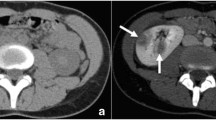Abstract
Utilization of color power Doppler and sonographic contrast agents to basic ultrasound (US) further improve the detection and characterization of abdominal injuries, increasing the diagnostic accuracy and value of US as an important technique in the evaluation of the abdominal trauma. This paper provides an illustrated summary of our clinical experience with color power Doppler US (CD-US) and contrast-enhanced US (CE-US) in the evaluation of abdominal solid organ injuries, involving 32 documented cases over a 2-year period. The findings of the CD-US and CE-US were compared with those provided by state-of-the-art contrast-enhanced multidetector 16-row CT.





Similar content being viewed by others
References
Hagspiel KD (1997) Abdominal trauma. In: Heller M, Fink A (eds) Radiology of trauma. Springer, Berlin Heidelberg New York, pp 125–161
Sato M, Yoshii H (2004) Reevaluation of ultrasonography for solid-organ injury in blunt abdominal trauma. J Ultrasound Med 23:1583–1596
Nural MS, Yardan T, Guven H, Baydin A, Bayrak IK, Kati C (2005) Diagnostic value of ultrasonography in the evaluation of blunt abdominal trauma. Diagn Interv Radiol 11:41–44
Scaglione M (2004) The use of sonography versus computed tomography in the triage of blunt abdominal trauma: the European perspective. Emerg Radiol 10(6):296–298
Bode PJ, Edwards MRJ, Kruit MC, van Vugt AB (1999) Sonography in a clinical algorithm for early evaluation of 1671 patients with blunt abdominal trauma. Am J Roentgenol 172:905–911
Brown MA, Casola G, Sirlin CB et al (2001) Blunt abdominal trauma: screening US in 2693 patients. Radiology 218:352–358
Bode PJ, Niezen RA, van Vugt AB, Schipper J (1993) Abdominal ultrasound as a reliable indicator for conclusive laparotomy in blunt abdominal trauma. J Trauma 34:27–31
Farahmand N, Sirlin CB, Brown MA, Shragg GP, Fortlage D, Hoyt DB, Casola G (2005) Hypotensive patients with blunt abdominal trauma: performance of screening US. Radiology 29:32–42
Yoon W, Jeong YY, Kim JK, Seo JJ, Lim HS, Shin SS, Kim JC, Jeong SW, Park JG, Kang HK (2005) CT in blunt liver trauma. Radiographics 25(1):87–104
Rhea JT, Garza DH, Novelline RA (2004) Controversies in emergency radiology. CT versus ultrasound in the evaluation of blunt abdominal trauma. Emerg Radiol 10(6):289–295
Shanmuganathan K, Mirvis SE, Sherbourne CD et al (1999) Hemoperitoneum as the sole indicator of abdominal visceral injuries: a potential limitation of screening abdominal US for trauma. Radiology 212:423–430
Poletti PA, Kinkel K, Vermeulen B et al (2003) Blunt abdominal trauma: should US be used to detect free fluid and organ injuries? Radiology 227:95–103
Nilsonn A, Loren I, Nirhow N, Lindhagen T, Nilsson P (1999) Power Doppler ultrasonography: alternative to computed tomography in abdominal trauma patients. J Ultrasound Med 18:669–672
Miele V, Buffa V, Stasolla A et al (2004) Contrast enhanced ultrasound with second generation contrast agent in traumatic liver lesions. Radiol Med 108(1–2):82–91
Catalano O, Lobianco R, Raso MM, Siani A (2005) Blunt hepatic trauma: evaluation with contrast-enhanced sonography: sonographic findings and clinical application. J Ultrasound Med 24(3):299–310
Gaiani S, Casali A, Serra C, Piscaglia F, Gramantieri L, Volpe L, Siringo S, Bolondi L (2000) Assessment of vascular patterns of small liver mass lesions: value and limitation of the different Doppler ultrasound modalities. Am J Gastroenterol 95(12):3537–3546
Forsberg F, Lathia JD, Merton DA, Liu JB, Le NT, Goldberg BB, Wheatley MA (2004) Effect of shell type on the in vivo backscatter from polymer-encapsulated microbubbles. Ultrasound Med Biol 30(10):1281–1287, Oct
Zheng RQ, Zhou P, Kudo M (2004) Hepatocellular carcinoma with nodule-in-nodule appearance: demonstration by contrast-enhanced coded phase inversion harmonic imaging. Intervirology 47:184–190
Ding H, Wang WP, Huang BJ, Wei RX, He NA, Qi Q, Li CL (2005) Imaging of focal liver lesions: low-mechanical-index real-time ultrasonography with SonoVue. J Ultrasound Med 24(3):285–297
Poletti PA, Platon A, Becker CD, Mentha G, Vermeulen B, Buhler LH, Terrier F (2004) Blunt abdominal trauma: does the use of a second-generation sonographic contrast agent help to detect solid organ injuries? Am J Roentgenol 183(5):1293–1301
Author information
Authors and Affiliations
Corresponding author
Rights and permissions
About this article
Cite this article
Sparano, A., Acampora, C., di Nuzzo, L. et al. Color power Doppler US and contrast-enhanced US features of abdominal solid organ injuries. Emerg Radiol 12, 216–222 (2006). https://doi.org/10.1007/s10140-006-0470-3
Received:
Accepted:
Published:
Issue Date:
DOI: https://doi.org/10.1007/s10140-006-0470-3




